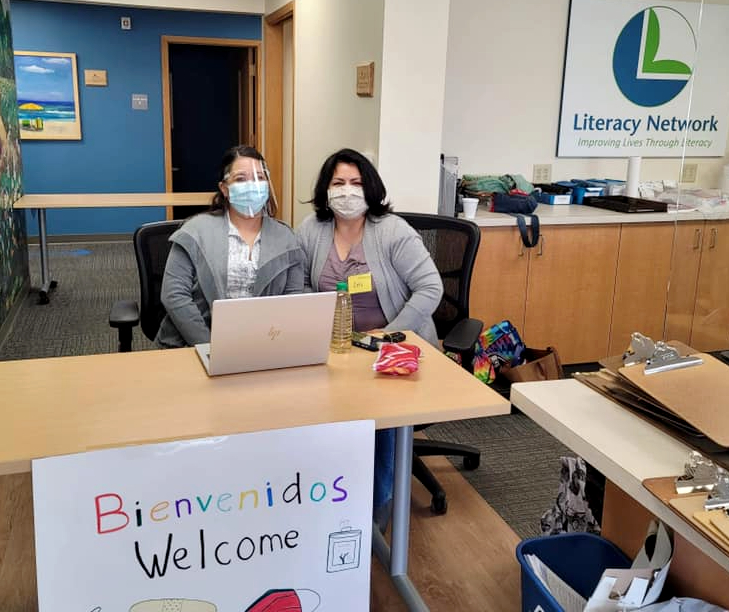
The past few months, Literacy Network launched a campaign to reach hundreds of community members through COVID-19 vaccine education to improve vaccination rates among adults of color. With that effort, Literacy Network helped increased vaccination rates among its target population from 26 to nearly 80 percent.
In fact, with the support of a grant from the Wisconsin Department of Health Services, Literacy Network’s community outreach efforts have resulted in a higher vaccination rate than the average for Dane County, which has the highest vaccination rates in the state of Wisconsin.
“We applied for the DHS grant and were notified that sometime in April we would get it. In our plan, we basically said that we would develop a curriculum and deliver it as soon as possible … get it into all of our classes,” Literacy Network Executive Director Jeff Burkhart tells Madison365. “By May, we had delivered it to most, if not all of our classes — that’s about 400 students total who saw that.”
Literacy Network, a non-profit organization working to improve adult literacy in Dane County, has programs that teach reading, writing, communication, and computer skills to adults and serves a clientele that is 95 percent people of color. This spring, the non-profit developed a multipronged approach to increase vaccination rates which included designing and implementing vaccine lesson plans, creating social media posts with accessible, accurate vaccine information, and hosting two vaccine clinics in partnership with Fitchburg Community Pharmacy.

“Students across all of my classes were very engaged with the vaccine lessons, asked a lot of insightful questions in class, and shared their own stories very candidly. I think it says so much that when students get one of their vaccine shots, many of them proudly announce it in class!” said ESL Instructor Marie Simpson. “I think our lessons — delivered by trusted teachers and tutors — helped students feel comfortable making a decision about the vaccine.”
“By the time we wrapped up the campaign in early June, we saw pretty dramatic impacts,” Burkhart says. “The number went up to almost 80 percent. We were seeing vaccination rates in Dane County go up all over Dane County during that period of time, but we went from well below average for all of our students to well above the average in just about two months.”
In April and May, Ingrid Ortiz, originally from Bolivia, hosted a a COVID vaccination clinic at Literacy Network.

“They brought their whole group in – like 20 people – and they were working with the Fitchburg Family Pharmacy and it was almost all Spanish speakers who were attending the vaccination clinic. That was pretty cool,” Burkhart remembers. “We had 114 people attend the first event. We were able to vaccinate a good number of our students.”
Burkhart says that his students had a variety of questions that they asked about the vaccine at the beginning of the cmapaign.
“We asked people what kinds of questions they had about the vaccine in both surveys. Some of the questions were: Are vaccines safe? Can people who are undocumented get the vaccine? Can I get COVID from the vaccine? What are the secondary effects of the vaccine? Which vaccine is better?
“We try to build answers to those questions using the best available data into the curriculum and then we made sure that there was an open forum in the classroom to talk,” he adds. “I think this shows that our teachers and tutors are among the most trusted people in our students’ lives. Week in and week out, they know that we have the best interest of our students in mind when we are working with them.”
Literacy Network will continue its vaccination education efforts in the coming months.
“We’ve been really trying to educate ourselves as well about the impact of COVID and the impact of the vaccine to ensure that we are as knowledgeable as we can be as an organization about COVID so that we can help inform our students,” Burkhart says.
Literacy Network is well-known in Dane County for teaching reading, writing, communications skills and computers skills but the real difference they make in people’s lives is often by helping them achieve better health, financial security and a deeper engagement with their families and the community.
“For a long time, we’ve been making sure that people can access good health information because we think that’s a really important part of literacy as a whole,” Burkhart says. “To really function in society, it’s really important that you understand information that’s coming at you from all different venues that are going to impact not only your job or your kid’s schooling but your health and your interaction with the health care system and your ability to take care of yourself and your family.”



